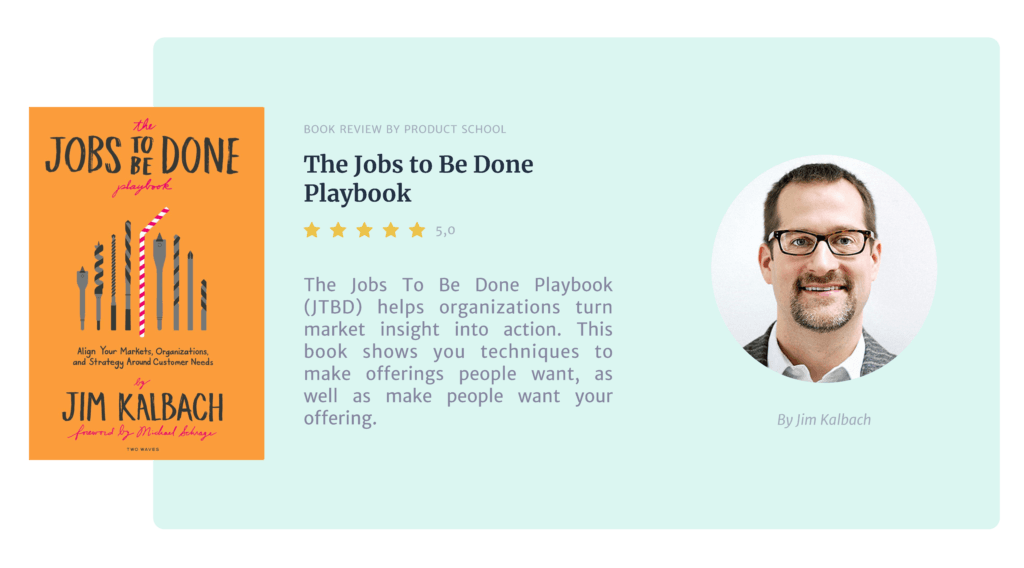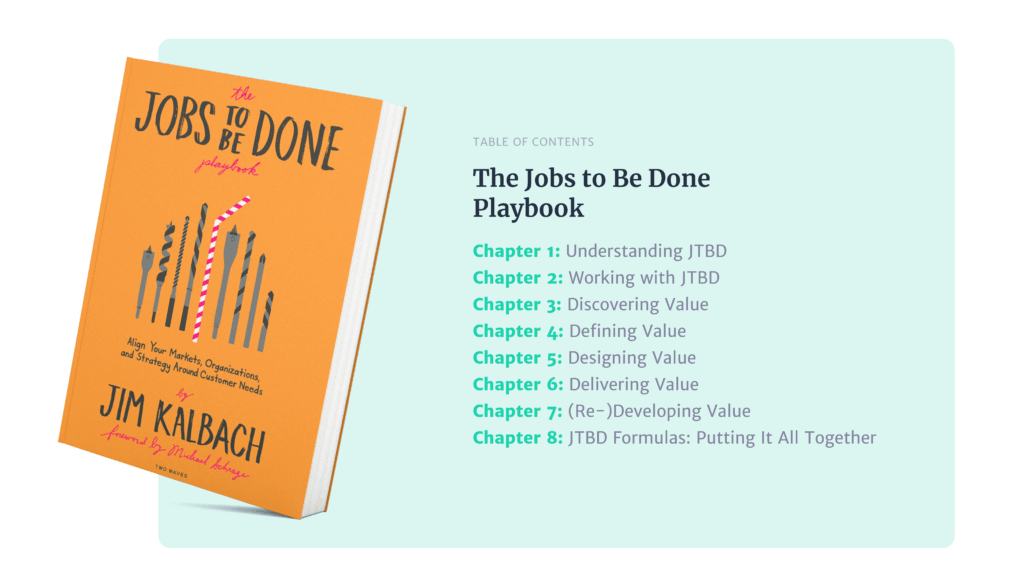Updated: November 28, 2024- 9 min read
What’s a product that can’t solve your users’ problems? A bad product. It’s no secret that successful products help users to get the “job” done. And if it can’t do that, customers immediately stop using it.
This is why frameworks shouldn’t be overlooked by Product Managers. A good one can help you launch a product that gets the “job” done. Jobs-to-Be-Done (JTBD) is that framework. It tells you how to create products that people will buy or subscribe to.
With JTBD you’re not trying to just solve a problem, but figure out what the right problem to solve is.

This month, for our book review, we interviewed Jim Kalbach, author of The Jobs to Be Done Playbook.
From Music in the 90s to Master of User Experience in 2020
Jim is currently Head of Customer Experience at MURAL where he leads the customer success, support, and consulting teams. Throughout his professional career he has moved from one discipline to another. From the outside, this might seem very disjointed, but in Jim’s mind, it all makes sense.
During college, Jim studied music composition. “I’m not a very good performer, but I was interested in theory, but studied information science as well.”Back in the 90s, he was an early adopter of online universities and email. This was definitely a bit ahead of the internet boom but definitely a great place to be in the mid-90s. He was already online when Amazon and other top tech companies came on. This is why he got into usability and then eventually User Experience, and all aspects of UX design.
“I moved from agencies to big companies. So I’ve kind of seen things from different perspectives, mostly in software design, as well as websites, but also web applications.”
Jim has devoured a lot of literature and techniques over the years. In the early 2000s he and his teammates were trying to define what User Experience was.
He came across Jobs to Be Done (JTBD) in 2003, pretty early on considering the hype around it these days. “I tried to involve JTBD in my professional development and in my practices too. I understand the theory and I’ve been implementing it for over the past 15 years.”
This has been Jim’s way of working JTBD out and this culminated in launching The Jobs to Be Done Playbook.
What Does Jim’s Typical Day Looks Like
You guessed right! There’s no typical day for Jim. Each day brings its own colors.
“As Head of Customer Experience at MURAL, I work from home. We have a fully remote team and that was one of the conditions I wanted in my next job. I previously worked for Citrix, the makers of GoToMeeting which is a remote collaboration solution. I was a remote employee there as well and I was working in a remote collaboration space. So when I moved to MURAL I wanted to keep my remote situation, but I also wanted to work in the remote collaboration space.”
Jim’s days at MURAL are packed with one-on-one meetings and management. He’s leading a team of 22 people. MURAL’s distributed team goes from California to Amsterdam to Buenos Aires, and more cities. It means working with people in 3 continents and 9 different time zones. Daily leadership meetings and spending time communicating and connecting with customers are an important part of his days too.
“I stay very close to our accounts and customers. I like to see what people are doing with the product firsthand and help them directly. I feel that’s important. Even though I’m the Head of Customer Experience, I want to be close to the action so that I can understand our customers’ experience. I spend a lot of time with our customers.”
How The Jobs to Be Done Playbook Came to Life
This wouldn’t be the first time Jim Kalbach wrote a book. In 2007 Jim published his first full-length book, Designing Web Navigation. His second book, Mapping Experiences was launched in 2016 and it focuses on the role of visualizations in strategy and innovation.
Given that Jim has written a book before and that he has enough JTBD theoretical and practical knowledge, putting all his ideas down on paper was the right decision. This is what led him to launch The Jobs to Be Done Playbook in April of 2020.

“I’m always watching what’s happening in the field. I’m trying to use it as much as I can in my own practice. This is why I decided to write the JTBD Playbook.”
What Can You Learn From the Jobs to Be Done Playbook
Jobs to Be Done doesn’t come from one discipline. Regardless of your job title, you can get something out of this book. It’s for a wide range of disciplines, from Marketing to Product Management to Design to even HR.
The Jobs to Be Done Playbook is for those who want to grow their business or organization.
“It’s for people that want to create value for their customers. And that’s why I positioned the book around creating value. Because that could be a government organization or also a Marketing team, Customer Success team, Product Managers, Product Designers. So it’s less of who and more of what are they trying to do?”This book will definitely shine a new perspective on how people think about creating value and experiences as an organization. No matter what position you hold, everyone should be contributing to the value.
JTBD Is Not a Method But a Way of Seeing
The JTBD Playbook takes a more neutral stance.
“There are different schools of thought that have their own perspective and that’s fine. But I do want to frame Jobs to Be Done broadly. It’s not a design method. It’s actually not even a method. It’s a way of seeing. And for me, JTBD is really about a perspective or a mindset. Sometimes I call it ‘Jobs Thinking’ at the risk of creating a new buzzword.”
Jim puts the word “thinking” on purpose so everyone understands how Jobs to Be Done can give you a unique perspective on the problem you’re trying to solve.

“It’s not the only perspective and it’s not going to reinvent the world for you, but it’s another data point. A different angle is that when you bring that in with your traditional Product Management motions, and then you add this new perspective, it gives you a richer picture and adds something unique that other existing fields like Product Management or Design typically don’t have. I want to show how anyone can inject this unique perspective into normal business motions.”
Rather than just reading about theory, you will find a handful of practical information broken down into individual techniques, exercises and recipes that you can later implement into your product or startup.
A Jobs to Be Done Definition Anyone Can Understand
“Why did the chicken cross the road?” is a very common American joke. The answer: to get to the other side.
Even if it’s not a common example, this riddle joke is what Jim uses to explain JTBD.
“The chicken’s job is to get to the other side. And you, as an organization need to understand the process of getting to the other side in detail and look for opportunities there. Of course, the chicken also has desired outcomes from getting the job done too, as well as aspirations to make progress in its life. These things play a role too. But understanding the main job is the first step. ”
“Then I go on to talk about how you need to interview chickens and look at the chickens’ needs and compare their needs. I use this example of a chicken crossing the road, but it’s surprising because if you create a job map—a technique inside of Jobs to Be Done—for crossing the road, I actually came up with at least 12 different steps that would have to go:
You have to decide to cross the road
Select a point in the road to cross
Choose a time to cross
Check for the absence of traffic
Monitor traffic as you’re crossing the road
Adjust your speed if the traffic comes right
And many more steps to get to the other side”
It’s almost fascinating that Jim takes a basic riddle joke and applies Jobs to Be Done techniques because it becomes a very rich conversation around crossing the road. And that’s the point of JTBD.“You can take something as obvious and as simple as ‘why are people using our product?’ You have to break that down in detail to help you pinpoint opportunities. JTBD is a language that helps you achieve this. It’s a framework that puts labels on things, categorizes it, but then also allows us to describe the outside world in a systematic way.”
Key Takeaways from “The Jobs to Be Done Playbook“
#1 Seeing customers as individuals
“There are other ways of looking at people other than seeing them as users of a product and to truly look at them as individuals and removing yourself from the equation is really healthy. It points to new growth opportunities. There are potential opportunities that you can discover by flipping your perspective and JTBD helps you do that.”
#2 Jobs be done is not a single method
“I want to suggest that JTBD is a way of thinking and a mindset rather than a specific method. And also that Jobs to Be Done actually has a long history. There’s lots of people who have worked with it over decades. Even though there’s a lot of hype about it right now, Jobs to Be Done is not a new thing. It has a lot of practices that come along with it.”
If you want to take your product to the next level and create more value for your users, it’s time to pick up your copy of The Jobs to Be Done Playbook here. Inside, you will also find a hub that points to external resources and expert advice in case you want to understand other practices in more detail like job maps, job stories or even roadmaps.

Meet Jim Kalbach
Jim Kalbach is a noted author, speaker, and instructor in design, customer experience, and strategy. He is currently Head of Customer Experience at MURAL, the leading online whiteboard. Jim has worked with large companies, such as eBay, Audi, SONY, Elsevier Science, LexisNexis, and Citrix.
In 2007 Jim published his first full-length book, Designing Web Navigation (O’Reilly, 2007). His second book, Mapping Experiences (O’Reilly, 2016), focuses on the role of visualizations in strategy and innovation. He blogs at experiencinginformation.com and tweets under @jimkalbach.
Updated: November 28, 2024




